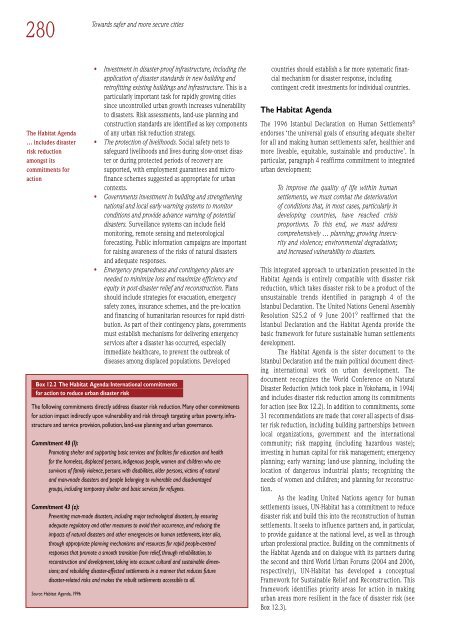Download the file - United Nations Rule of Law
Download the file - United Nations Rule of Law
Download the file - United Nations Rule of Law
- No tags were found...
Create successful ePaper yourself
Turn your PDF publications into a flip-book with our unique Google optimized e-Paper software.
280Towards safer and more secure citiesThe Habitat Agenda… includes disasterrisk reductionamongst itscommitments foraction• Investment in disaster-pro<strong>of</strong> infrastructure, including <strong>the</strong>application <strong>of</strong> disaster standards in new building andretr<strong>of</strong>itting existing buildings and infrastructure. This is aparticularly important task for rapidly growing citiessince uncontrolled urban growth increases vulnerabilityto disasters. Risk assessments, land-use planning andconstruction standards are identified as key components<strong>of</strong> any urban risk reduction strategy.• The protection <strong>of</strong> livelihoods. Social safety nets tosafeguard livelihoods and lives during slow-onset disasteror during protected periods <strong>of</strong> recovery aresupported, with employment guarantees and micr<strong>of</strong>inanceschemes suggested as appropriate for urbancontexts.• Governments investment in building and streng<strong>the</strong>ningnational and local early warning systems to monitorconditions and provide advance warning <strong>of</strong> potentialdisasters. Surveillance systems can include fieldmonitoring, remote sensing and meteorologicalforecasting. Public information campaigns are importantfor raising awareness <strong>of</strong> <strong>the</strong> risks <strong>of</strong> natural disastersand adequate responses.• Emergency preparedness and contingency plans areneeded to minimize loss and maximize efficiency andequity in post-disaster relief and reconstruction. Plansshould include strategies for evacuation, emergencysafety zones, insurance schemes, and <strong>the</strong> pre-locationand financing <strong>of</strong> humanitarian resources for rapid distribution.As part <strong>of</strong> <strong>the</strong>ir contingency plans, governmentsmust establish mechanisms for delivering emergencyservices after a disaster has occurred, especiallyimmediate healthcare, to prevent <strong>the</strong> outbreak <strong>of</strong>diseases among displaced populations. DevelopedBox 12.2 The Habitat Agenda: International commitmentsfor action to reduce urban disaster riskThe following commitments directly address disaster risk reduction. Many o<strong>the</strong>r commitmentsfor action impact indirectly upon vulnerability and risk through targeting urban poverty, infrastructureand service provision, pollution, land-use planning and urban governance.Commitment 40 (l):Promoting shelter and supporting basic services and facilities for education and healthfor <strong>the</strong> homeless, displaced persons, indigenous people, women and children who aresurvivors <strong>of</strong> family violence, persons with disabilities, older persons, victims <strong>of</strong> naturaland man-made disasters and people belonging to vulnerable and disadvantagedgroups, including temporary shelter and basic services for refugees.Commitment 43 (z):Preventing man-made disasters, including major technological disasters, by ensuringadequate regulatory and o<strong>the</strong>r measures to avoid <strong>the</strong>ir occurrence, and reducing <strong>the</strong>impacts <strong>of</strong> natural disasters and o<strong>the</strong>r emergencies on human settlements, inter alia,through appropriate planning mechanisms and resources for rapid people-centredresponses that promote a smooth transition from relief, through rehabilitation, toreconstruction and development, taking into account cultural and sustainable dimensions;and rebuilding disaster-affected settlements in a manner that reduces futuredisaster-related risks and makes <strong>the</strong> rebuilt settlements accessible to all.Source: Habitat Agenda, 1996countries should establish a far more systematic financialmechanism for disaster response, includingcontingent credit investments for individual countries.The Habitat AgendaThe 1996 Istanbul Declaration on Human Settlements 8endorses ‘<strong>the</strong> universal goals <strong>of</strong> ensuring adequate shelterfor all and making human settlements safer, healthier andmore liveable, equitable, sustainable and productive’. Inparticular, paragraph 4 reaffirms commitment to integratedurban development:To improve <strong>the</strong> quality <strong>of</strong> life within humansettlements, we must combat <strong>the</strong> deterioration<strong>of</strong> conditions that, in most cases, particularly indeveloping countries, have reached crisisproportions. To this end, we must addresscomprehensively … planning; growing insecurityand violence; environmental degradation;and increased vulnerability to disasters.This integrated approach to urbanization presented in <strong>the</strong>Habitat Agenda is entirely compatible with disaster riskreduction, which takes disaster risk to be a product <strong>of</strong> <strong>the</strong>unsustainable trends identified in paragraph 4 <strong>of</strong> <strong>the</strong>Istanbul Declaration. The <strong>United</strong> <strong>Nations</strong> General AssemblyResolution S25.2 <strong>of</strong> 9 June 2001 9 reaffirmed that <strong>the</strong>Istanbul Declaration and <strong>the</strong> Habitat Agenda provide <strong>the</strong>basic framework for future sustainable human settlementsdevelopment.The Habitat Agenda is <strong>the</strong> sister document to <strong>the</strong>Istanbul Declaration and <strong>the</strong> main political document directinginternational work on urban development. Thedocument recognizes <strong>the</strong> World Conference on NaturalDisaster Reduction (which took place in Yokohama, in 1994)and includes disaster risk reduction among its commitmentsfor action (see Box 12.2). In addition to commitments, some31 recommendations are made that cover all aspects <strong>of</strong> disasterrisk reduction, including building partnerships betweenlocal organizations, government and <strong>the</strong> internationalcommunity; risk mapping (including hazardous waste);investing in human capital for risk management; emergencyplanning; early warning; land-use planning, including <strong>the</strong>location <strong>of</strong> dangerous industrial plants; recognizing <strong>the</strong>needs <strong>of</strong> women and children; and planning for reconstruction.As <strong>the</strong> leading <strong>United</strong> <strong>Nations</strong> agency for humansettlements issues, UN-Habitat has a commitment to reducedisaster risk and build this into <strong>the</strong> reconstruction <strong>of</strong> humansettlements. It seeks to influence partners and, in particular,to provide guidance at <strong>the</strong> national level, as well as throughurban pr<strong>of</strong>essional practice. Building on <strong>the</strong> commitments <strong>of</strong><strong>the</strong> Habitat Agenda and on dialogue with its partners during<strong>the</strong> second and third World Urban Forums (2004 and 2006,respectively), UN-Habitat has developed a conceptualFramework for Sustainable Relief and Reconstruction. Thisframework identifies priority areas for action in makingurban areas more resilient in <strong>the</strong> face <strong>of</strong> disaster risk (seeBox 12.3).
















